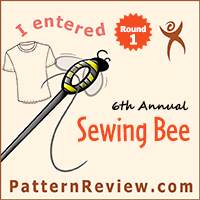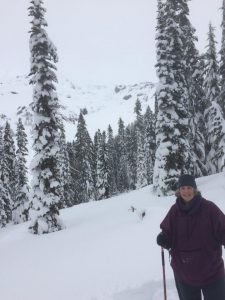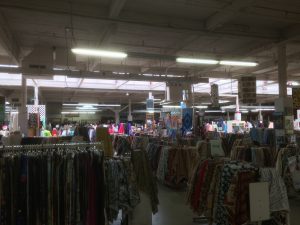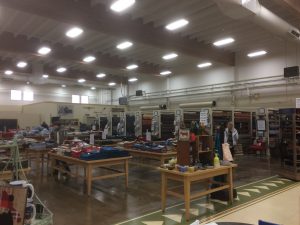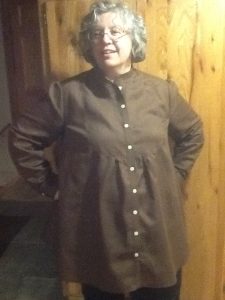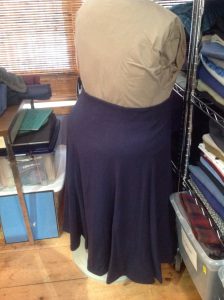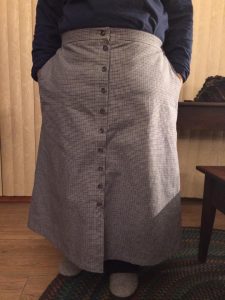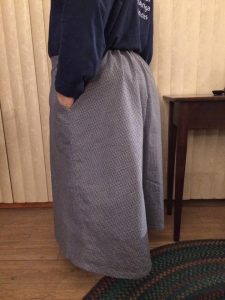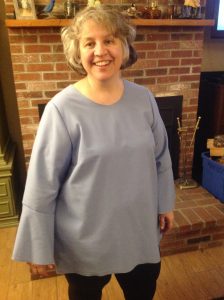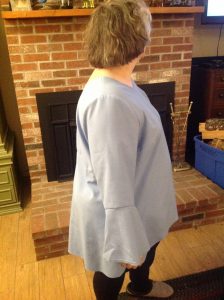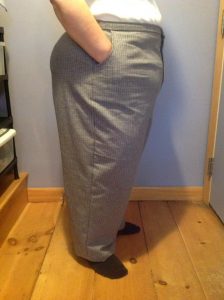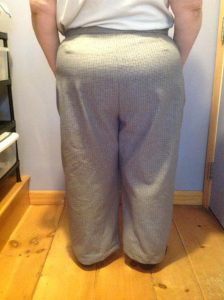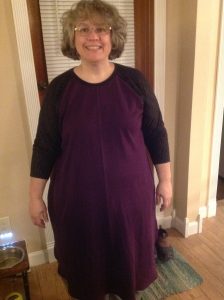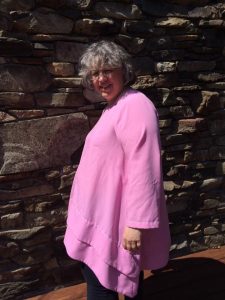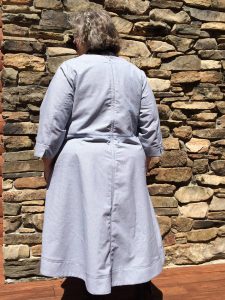I have always dreamed of traveling. In recent years, I have traveled to Scotland, Switzerland, Ireland, and did many car trips, including one to Florida, and another to Cape Breton, Nova Scotia in Canada. I toured Scotland with my daughter, who insisted I leave my suitcase home, and instead I traveled with a 30 lb backpack for 8 days. In Switzerland, I spent 10 days, hiking, doing walking tours, scrambling through a castle, hopping boats, horse-drawn wagons, and trains, and eating in fine restaurants, all requiring careful consideration of my wardrobe. My husband and I love road trips, and averaged at least one road trip a month last year. Having just completed a year packed full of travel, I learned a lot, about what I want to wear on my future adventures. Having a well tailored, comfortable, versatile, condensed, attractive wardrobe makes all the difference while traveling. As I travel more and more, I also want to find ways to pursue my obsession with sewing while on the road. I left for a road trip just two days after the round 4 challenge of the sewing bee was announced. The trip had been planned months ago, and I never thought I would make it to round 4. Never, say, never. Suddenly, I needed to pack up a streamlined sewing studio and hit the road. I formulated my plan, picked patterns, pulled fabrics from my stash, made a few purchases, and made up some quick muslins. I then cut all the garments, applied interfacings where needed, and I serged all the edges to keep the raveling to a minimum. There were a number of snags along the way, but, I adapted and overcame. I am so pleased with my outfit, but also for my successful proof of concept of sewing on the road. When my husband does eventually retire, I hope our future holds many more adventures on the road, but I worried that it would drastically cut into my sewing time. This outfit was the result of my first attempt at creating travel worthy garments using my portable, yet comprehensive sewing studio.
I present to you my traveling outfit. This is comprised of four pieces: a dress, a blouse, a pair of pants, and a short kimono jacket. The dress is a full length dress, with a rounded collar, tulip sleeves, inseam pockets, a button band with 17 buttons, and can easily be converted into a duster. The blouse is reversible, featuring a hi low split hem, delicate trim on neckline and armscye, and pintucking on one side. The pants are pull on linen pants with side in seam flat felled pockets, a very comfortable high waisted, wide triple elastic waistband, and cuffable pant legs for an impromptu walk on the beach. The jacket is a short reversible kimono jacket, made with denim and linen, featuring patch pockets and a bound buttonhole with back to back buttons for reversibility. This versatile comfortable attractive 4 piece ensemble can be mixed and matched for many different looks, making it perfect for traveling.
The dress is a self drafted pattern using my sloper created with the Sure Fit designs dress kit. The dress features princess seams, tulip sleeves, full length front cut on button placket, and a 3/4 circle skirt bottom. It is made with 6 yards of Robert Kaufman’s Brussels Washer Navy. The blend of linen and rayon has a lovely drape, that dances around my legs as I walk. It is long, cool, comfortable, and with an extra couple of buttons and buttonholes, it converts into a duster or long vest. This idea came to me when I found myself touring through a castle full of winding staircases in a lovely long dress. To safely navigate, I buttoned up the dress on itself, it looked strange, but it worked. This is a more attractive version, which can easily convert into several very flattering looks. I placed a button on the inside bottom of each button band. I also attached tabs with buttonholes along the back princess seams at the waistline. This allows two different levels of drape. I wanted to use flat felled seams but, this was not compatible with curvy princess seams so I devised a clean finish, that transitioned to a flat felled seam below the waist. The armscye seam allowances are bound with bias to keep it neat. The curve in collar mimics the curvy tulip sleeves. The tulip sleeves are large upper arm friendly, and add width to my narrow shoulders, balancing out my overall pear shape, and giving the impression of more of an hour glass shape. I feel absolutely fabulous in this dress.
The top is a reversible pull over top. The white side is pintucked. The neckline and armscye is trimmed with a white flat piping. The bottom is finished with a hi-lo split hem. It is made with white handkerchief weight linen, and a lightweight printed linen. It is cool, comfortable, and provides two looks with one garment. The pattern is self drafted from my sloper. It is dartless. I challenged myself to find a way to make it reversible. I had these lovely yet sheer linen, that I would not use alone, but together in reversible top was perfect. The pintucking was done on my serger, and gives the garment a little structure. The construction was tricky to figure out and was achieved in a hotel room late at night with a couple of scraps of cotton, resulting in a mini mockup. The shoulder seams are sewn on both tops. I sewed a bias strip folded in half around neckline of one top. I then layered tops right sides together, and used the first stitching as guide to stitch neckline on both shirts. The flat piping made it very easy to turn the shirt. The armscye’ s were done similarly, but the trim must not fall within seam allowances. I used burrito method the sew the arm scye’s right sides together after trim was applied. I then sewed the side seams down to the start of the split hem. I used the burrito method once again to finish the front hem. I left a gap in the back hem to allow for turning right sides out. I also cut the white side of shirt an additional half an inch longer in the front resulting in a thin white edge on the front lower hems of both shirts to coordinate with the other trim. I skipped white trim on back hem for practicality. I will repeat this pattern again, but next time I want to try using some, lovely lawn print with some handkerchief weight linen for an even lighter more fluid effect.
The pants were from a tried and true pattern. Being a short plus size pear shaped woman, makes making pants for myself a major endeavor. All pants patterns require extensive alterations to fit me comfortably while sitting, standing, and walking. I have a tilted waist and wacky crotch depth and crotch curves. Many muslins were done, and with every make I tweak and enhance the fit and finish of this pattern. I love these pants, which are as comfortable as my knit leggings, but are much more flattering. This pair of pants is made in a heavy weight linen. The seams are flat felled, with side in-seam pockets. The triple elastic waistband is wide, comfortable, and attractive. I added an additional 1/8 inch of top stitching along the very top edge of the waistband, which adds a bit of polish. I added linings to the lower legs to allow cuffing, and to provide a pop of color and coordination with other pieces in my travel wardrobe. I also eliminated the front waist pleats, and added back waist darts to my version of the pattern for a better fit. The pattern is a free PDF download from “Fabric-stores.com”, and is called the Crisp Linen Pants Pattern. The pattern accommodates sizes 0/2 to 28/30, in Letter/A4 paper. The instructions are provided via an online tutorial, with separate links for detailed instructions on several techniques such as flat-felled seams, and putting a pocket in a flat felled seam. There are no licensing restrictions as well. These pants are perfect for the impromptu walk on the beach, as well as throwing on some heels and heading to dinner.
The jacket is the Women’s Kimono Jacket sewing pattern, from Wiksten. Although the pattern only extends to XL, it is a loose boxy style, which I thought could work well for my plus size figure, with some adjustments. I chose the short jacket version, but shortened it an additional 2 inches. I shortened the sleeves an inch, as well. I also added a rounded triangle to the back of the collar piece to expand the flip down collar on the jacket, which could then conceal the collar on the dress, avoiding the double collar conundrum. I am not a fan of open jackets, so I also added a bound button hole and two back to back buttons. Being reversible, it offers two looks, in one garment. One side is a denim I purchased from Vogue fabric, several years ago. The second side is Robert Kaufman’s Brussels Washer YD denim, purchased from Pintuck & Purl, an amazing shop in North Hampton, NH. This jacket feels so lush. I typically shy away from loose boxy styles, but with a few minor adjustments, this jacket broadens out my shoulders, balances out my pear shaped figure, and draws the attention up to my face and upper body.
Round 4 started in snowy cold New Hampshire. I cut all of my garments out, and then packed up a mini sewing studio and headed south for warmer climates. Not long into the drive, I discovered I had cut the dress for a scoop neck, instead of a collared neckline. I re-cut those pieces on a king size bed in a Hampton Inn. Thank goodness for my emergency backup supply of fabric. During the 2.5 day drive, I basted seams, planned construction, started my review, and fretted about how I was going to get it all done. Once in Florida, I setup in the sunny game room, complete with a ping pong table, which worked beautifully as my sewing studio away from home. Now that the sewing is done, I am packing up the traveling sewing studio, unloading my bike, and I am heading out to catch up on some much needed sunshine, fresh air, and exercise, confident that I can bring my sewing along on my future travels, with planning and preparation.
Why should I win the sewing bee? Like my fellow contestants, I love to sew. For me sewing is the perfect combination of mathematics, engineering, and artistry. Sewing is a constant source of challenge, frustration, and provides a true sense of accomplishment. When I sew, my focus and concentration takes me to another world. Sewing for me started with quilting, which I did for nearly 20 years, and then one day I stopped. I had had enough of quilting. Soon after, my daughter needed a prom dress, so I bought a book on couture, dusted off my sewing machine, and made her a gorgeous gown, in satin, with boning, and tulle. It took several months, and for my first muslin, I used actual muslin, which makes me laugh today. After the prom dress, I decided I would like to make myself a vest. How hard could that be? I bought a pattern, measured, sewed, and it looked beautiful until I put it on. It was even worse, when I sat down. Adjustments were needed. I bought a book on plus sizing fitting, and my next vest worked up much better. There are no magic patterns that work for me out of the envelope. I have studied and learned how to alter patterns for my plus size body. The next hurdle was to learn how to choose a fabric, and consider drape, durability, as well as visual impact. In the early days, there were too stiff skirts, unintended see thru tops, unfortunate pattern placements, and casualties that did not survive the washing machine. After all that, I was starting to make some really nice garments, but I found they did not always flatter my figure. So I then studied my proportions, and my shape, and how to pick patterns, fabrics, and styles that would balance out my figure. Suddenly, the success rate of my garment making soared. Today, I live in made by me clothes. I love making for me and friends and family. I love sharing my love of sewing. I would love to be able to go back to my curvy plus size online communities and say, I won the sewing bee, making and modeling my own perfectly plus garments. I think it would inspire a lot of others to navigate the labyrinth and come out the other side, to a place where you can make one of a kind garments, that make you feel absolutely fabulous.
Finally, a huge thank you to the Pattern Review team, and the guest judges. I appreciate the time of effort that went into making this event a reality. It has been a real game changer for me. Also, none of this would have been possible without my amazing husband who made countless meals, rubbed sore shoulders, hauled sewing machines and totes full of fabric and sewing supplies, and took the most wonderful photos.














